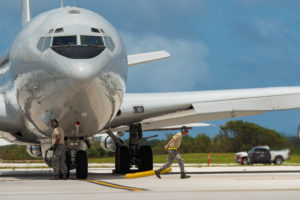The Air Force will require “bold and likely controversial changes” to its weapons portfolio to develop capabilities needed to fight on a future battlefield, the current service leader said Sept. 4.
“We need to shift funding and allegiance from legacy programs we can no longer afford due to their incompatibility for the future battle force, and into the capabilities and systems the nation requires,” said Acting Air Force Secretary Matt Donovan at the third annual Defense News Conference in Arlington, Virginia.

Donovan, who became acting service secretary following the May 31 resignation of Former Secretary Heather Wilson, noted that new Defense Secretary Mark Esper has expressed a willingness for the services to divest legacy capabilities that aren’t suited for a future battlefield against near-peer adversaries.
“He has set the department on a path to look for ways to divert funds from programs that don’t have as much value and to programs that increase critical warfighting capabilities,” Donovan said. “His guidance states that no reform is too small, too bold or too controversial to be considered.
“The Air Force is leading the way with bold and likely controversial changes to our future weapons,” he continued. “There’s no way around it; our Air Force as it exists today is not guaranteed to prevail in the scenario I present.”
Donovan did not elaborate on which platforms or capabilities could be targeted for divestment. The service has attempted in the past to retire aircraft including the A-10 attack aircraft and the U-2 reconnaissance aircraft, but were stopped by Congress. Lawmakers did agree to cancel the proposed Joint Strike Target and Attack Radar System (JSTARS) recapitalization program in the fiscal year 2019 National Defense Authorization Act (NDAA) in favor of investing in new advanced battle management system (ABMS) technologies.
Air Force Lt. Gen. Timothy Fay, deputy chief of staff for strategy, integration and requirements, said in a later panel at the conference that current plans to divest legacy aircraft do not include retiring the A-10.
“Short answer: no,” he said in response to a question on the topic.
Mike Griffin, the undersecretary of defense for research and engineering, similarly discussed the need to invest in more advanced technologies to deter peer adversaries.
While he asserted that legacy defense capabilities are not “obsolete” and continue to provide overmatch, “our adversaries know and understand these assets,” he said Wednesday at the conference.
“While we can’t give up on those things, we have to look to the future,” Griffin said, noting that the Chinese military has fielded thousands of conventional strike weapons.
“Which do you think the Chinese leadership would fear more: 2,000 conventional strike missiles possessed by the United States and its allies in the Western Pacific … or one new carrier? Because those two things cost about the same amount of money,” he said. “Those are the kinds of questions we need to be asking ourselves.”